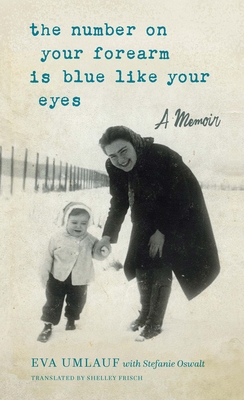The Number on Your Forearm Is Blue Like Your Eyes: A Memoir

The Number on Your Forearm Is Blue Like Your Eyes: A Memoir
In late April, Nora, Eva's sister, was born. Agnes Hecht remained in the camp infirmary until her two little girls were well enough to travel, then brought them back to her home in Trenčín in western Slovakia. Eva grew up with a mother who had to "survive her survival"--the little family lived with the loss in the Holocaust of the husband/father, the mother's three siblings, and the grandparents and great-grandparents. Having also lost her family's fortune, Agnes worked hard to create a normal home life for her daughters. Like many survivors in the post-Holocaust era, Eva's mother never talked about her experiences. Eva suffered frequent flare-ups of the illnesses she had suffered in Auschwitz. She did well at school and went on to study medicine in Bratislava. In 1966 she married Jakob Sultanik, a fellow Holocaust survivor who had resettled in Munich, Germany. Eva left the communist regime in Czechoslovakia in 1967 to join him in West Germany. There she began her practice as a pediatrician and later as a psychotherapist--and for the first time she had the opportunity to live out her Jewish identity. Unfortunately, Eva's husband, Jakob, died in a tragic accident when their son, Erik, was a small boy. Eva later married a fellow physician, Bernd Umlauf, and they had two sons, Oliver and Julian. Every so often, the horrors of Eva's early years would resurface in nightmares involving dead babies and Auschwitz gas chambers.
Having achieved prominence as a pediatrician, child therapist, and international speaker, Eva finally decided to tell her story. In 2016, at the age of seventy-four, with the assistance of journalist Stefanie Oswalt, Eva Umlauf publish
PRP: 155.61 Lei
Acesta este Pretul Recomandat de Producator. Pretul de vanzare al produsului este afisat mai jos.
140.05Lei
140.05Lei
155.61 LeiLivrare in 2-4 saptamani
Descrierea produsului
In late April, Nora, Eva's sister, was born. Agnes Hecht remained in the camp infirmary until her two little girls were well enough to travel, then brought them back to her home in Trenčín in western Slovakia. Eva grew up with a mother who had to "survive her survival"--the little family lived with the loss in the Holocaust of the husband/father, the mother's three siblings, and the grandparents and great-grandparents. Having also lost her family's fortune, Agnes worked hard to create a normal home life for her daughters. Like many survivors in the post-Holocaust era, Eva's mother never talked about her experiences. Eva suffered frequent flare-ups of the illnesses she had suffered in Auschwitz. She did well at school and went on to study medicine in Bratislava. In 1966 she married Jakob Sultanik, a fellow Holocaust survivor who had resettled in Munich, Germany. Eva left the communist regime in Czechoslovakia in 1967 to join him in West Germany. There she began her practice as a pediatrician and later as a psychotherapist--and for the first time she had the opportunity to live out her Jewish identity. Unfortunately, Eva's husband, Jakob, died in a tragic accident when their son, Erik, was a small boy. Eva later married a fellow physician, Bernd Umlauf, and they had two sons, Oliver and Julian. Every so often, the horrors of Eva's early years would resurface in nightmares involving dead babies and Auschwitz gas chambers.
Having achieved prominence as a pediatrician, child therapist, and international speaker, Eva finally decided to tell her story. In 2016, at the age of seventy-four, with the assistance of journalist Stefanie Oswalt, Eva Umlauf publish
Detaliile produsului









